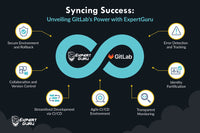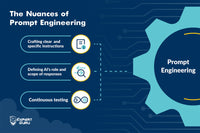In the fast-paced world of e-commerce, where giants dominate and competition is fierce, emerging brands often find themselves in an uphill battle for market share. However, there is hope on the horizon for young e-commerce businesses with limited budgets. By strategically tapping into blue ocean opportunities and harnessing the power of automation using AI, they can not only compete but also thrive.
Riding the Blue Ocean Waves: Finding New Customer Frontiers
Imagine the e-commerce landscape as a vast ocean, where sharks (incumbents) roam, and smaller fish (startups) are struggling to survive. The key to success is not to swim with the sharks but to find your own blue ocean, where new customers and streamlined buying experiences await.
Outrageous Claim
In the not-so-distant future, e-commerce brands will employ AI-powered psychic algorithms that predict what customers want even before they do.
Blue Ocean Strategy
a) Niche Down: Start by narrowing your focus to a specific niche or target audience. Millennials and Gen Z are particularly receptive to brands that understand their unique needs and preferences.
b) Customer-Centric UX Design: Invest in user experience (UX) design to streamline the buying process. Make it effortless, intuitive, and enjoyable for customers to browse, select, and purchase products.
c) Omni-channel Engagement: Utilize social media, email marketing, and influencer collaborations to reach new audiences. Engage with customers where they already spend their time.
Automation Revolution: AI as Your Silent Workforce
Now, let's meet Sarah, a hardworking millennial who recently became a working mom. She's juggling a career, parenting, and household responsibilities. Sarah represents the typical modern consumer, and her interactions with e-commerce brands illustrate the power of automation.
Stat 1: 47% of consumers are open to making a purchase from a chatbot. (Source: HubSpot)
Stat 2: AI-powered chatbots can help reduce cart abandonment rates by up to 30%. (Source: SaleCycle)
Stat 3: By 2022, chatbots and virtual assistants could help businesses save over $8 billion per year. (Source: Juniper Research)
Sarah's Story: A Day in the Life of a Working Mom
Sarah's mornings are chaotic, getting her baby ready while preparing for work. She decides to shop for her baby's essentials online. As she navigates an e-commerce site, a chatbot named "Max" pops up:
Max (Chatbot): "Hello, Sarah! I see you're looking for baby essentials. Can I help you find what you need?"
Impressed by Max's instant assistance, Sarah continues browsing. Max provides personalized product recommendations based on Sarah's previous purchases.
Max (Chatbot): "Sarah, I noticed you bought organic baby food last time. Here are some new arrivals you might like." After a seamless shopping experience, Sarah proceeds to checkout. Max ensures her cart doesn't become another abandoned one:
Max (Chatbot): "Sarah, don't forget to complete your purchase! We have a special offer for you today."
Sarah completes her purchase hassle-free, thanks to Max's assistance. Later, she receives an email from the e-commerce brand, addressing her by name and suggesting complementary products.
In this scenario, automation played a pivotal role in enhancing Sarah's shopping experience. The e-commerce brand used AI to understand her preferences, offer real-time assistance, and streamline post-purchase engagement.
Embrace the Future Today
E-commerce brands with limited budgets can defy the odds by exploring blue ocean opportunities and embracing automation through AI. By understanding their audience, optimizing user experiences, and leveraging AI-powered tools like chatbots, these brands can not only compete but also revolutionize the way consumers like Sarah shop online. The future of e-commerce is bright, and those who adapt will ride the waves of success.
In this evolving digital age, young brands have the chance to be the pioneers, the discoverers of their own blue oceans, and the architects of a brighter e-commerce future. It's not just about survival; it's about thriving in the age of automation. Are you ready to dive in?



























